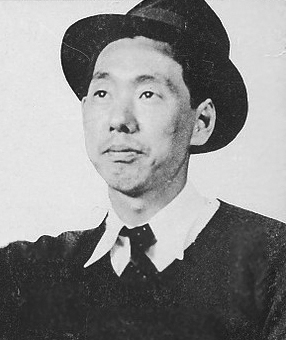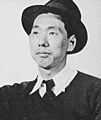Mikio Naruse facts for kids
Quick facts for kids
Mikio Naruse
|
|
|---|---|

Naruse in 1933
|
|
| Born | 20 August 1905 Tokyo, Japan
|
| Died | 2 July 1969 (aged 63) Tokyo, Japan
|
| Nationality | Japanese |
| Occupation | Film director, screenwriter, producer |
| Years active | 1930–1967 |
Mikio Naruse (成瀬 巳喜男, Naruse Mikio, 20 August 1905 – 2 July 1969) was a famous Japanese movie director. He made 89 films between 1930 and 1967.
Naruse's movies often showed a realistic and sometimes serious view of life. He mostly made films about "common people drama," called shomin-geki in Japanese. Many of his main characters were women, played by actresses like Hideko Takamine, Kinuyo Tanaka, and Setsuko Hara. His films are sometimes compared to those of Yasujirō Ozu because they both focused on family life and how old Japanese traditions mixed with new modern ways. Later in his career, Naruse often turned popular Japanese books into movies. Even though he was a very smart and important director during Japan's "golden age" of film, he is not as well-known as other directors like Akira Kurosawa, Kenji Mizoguchi, and Ozu. Some of his most famous films include Sound of the Mountain, Late Chrysanthemums, Floating Clouds, and When A Woman Ascends The Stairs.
Contents
About Mikio Naruse's Life
Starting His Career
Mikio Naruse was born in Tokyo, Japan, in 1905. His brother and sister raised him after his parents passed away when he was young. In the 1920s, he started working at the Shochiku film studio. He began as an assistant for the lighting crew and soon worked with comedy director Yoshinobu Ikeda.
Naruse directed his first film, a short comedy called Mr. and Mrs. Swordplay, in 1930. Another director, Heinosuke Gosho, helped him with the editing. This film was a success, and Naruse was then allowed to direct a romance film called Pure Love. Sadly, most of his early films from Shochiku, including these two, are now lost.
His oldest surviving film is the short movie Flunky, Work Hard! (1931), which mixes comedy with family drama. From 1933 to 1934, he made several silent dramas like Apart From You, Every-Night Dreams, and Street Without End. These films focused on women dealing with tough situations and everyday problems. They showed his great skill in filmmaking. Naruse was not happy with how things worked at Shochiku, so he left in 1934. He then moved to P.C.L. studios, which later became Toho, another big film company.
His first big film at the new studio was the comedy-drama Wife! Be Like a Rose! (1935). This movie was chosen as the Best Movie of the Year by a magazine called Kinema Junpo. It was also the first Japanese film to be shown in movie theaters in the United States. This film tells the story of a young woman whose father left his family for a former geisha. When she visits her father, she finds that his second wife is actually a better match for him than his first wife. Film experts have said this movie felt "modern" and had "new ways of showing things" and "forward-thinking ideas."
Some of Naruse's films in the years after Wife! Be Like a Rose! are not as highly praised by film historians. This was partly because of weak scripts and acting. Naruse himself later said that he didn't have the courage to turn down some projects back then. He tried to make up for weak stories with good filmmaking techniques, but it didn't always work.
During World War II, Naruse made what his biographer called "safe projects." These included films about life at home during wartime, like Sincerity. Around 1941, Naruse's first marriage ended. In the same year, he directed the comedy Hideko the Bus Conductor with Hideko Takamine, who would become one of his favorite actresses.
After the War
In 1951, Naruse made Repast, which marked a strong return for him. This film was the first of many movies he made based on the books of a female writer named Fumiko Hayashi. Other films based on her work include Lightning (1952) and Floating Clouds (1955). All these movies showed women struggling with unhappy relationships or family problems. They won important national film awards.
Late Chrysanthemums (1954), also based on Hayashi's stories, was about four former geisha trying to manage their money problems after the war. Sound of the Mountain (1954) showed a marriage falling apart, and Flowing (1956) showed a geisha house that was losing its business. These two films were based on novels by famous writers Yasunari Kawabata and Aya Kōda.
In the 1960s, Naruse made fewer films because he was often sick. However, film experts say his movies during this time became more emotional. When a Woman Ascends the Stairs (1960) tells the story of an older bar hostess who tries to start her own business. A Wanderer's Notebook (1964) followed the life of writer Fumiko Hayashi. His very last film was Scattered Clouds (1967). Two years later, in 1969, Mikio Naruse passed away from cancer at the age of 63.
People described Naruse as a serious and quiet person. Even his closest co-workers said they didn't know much about him personally. He rarely gave interviews. Director Akira Kurosawa said Naruse was very sure of himself and did everything on the movie set by himself. Actress Hideko Takamine, who was in about 20 of his films, remembered that he never told her if her acting was good or bad. He was a very quiet director.
Mikio Naruse's Film Style and Themes
Naruse is known for showing the Japanese idea of "mono no aware" in his films. This means being aware that things don't last forever and feeling a gentle sadness when they pass. Naruse himself once said, "From the youngest age, I have thought that the world we live in betrays us."
His main characters were usually women. His films explored the experiences of women from many different social backgrounds, jobs, and situations. Six of his films were based on the books of one writer, Fumiko Hayashi, whose serious view of life seemed to match his own. From her stories, he made films about love that wasn't returned, unhappy families, and difficult marriages.
In Naruse's films, characters are often surrounded by strong family ties and old customs. They are most vulnerable when they try to do something for themselves. He once said, "If they move even a little, they quickly hit the wall." This means that their hopes often lead to disappointment, true happiness seems impossible, and the best they can hope for is just to be content. About some of his films, Naruse said, "these pictures have little that happens in them and end without a conclusion–just like life."
Naruse's films often had simple stories, with not much talking. The camera work was not flashy, and the sets were simple. His earlier films had a more experimental style. But his later films were purposely slow and calm. This was done to highlight the everyday challenges and feelings of ordinary Japanese people, showing every small look, movement, and gesture in great detail.
Awards and Recognition
Mikio Naruse's films won many important awards:
- Wife! Be Like a Rose!
- Kinema Junpo Award for Best Film
- Repast
- Blue Ribbon Award for Best Film
- Mainichi Film Concours for Best Film and Best Director
- Lightning
- Blue Ribbon Award for Best Film and Best Director
- Mother
- Blue Ribbon Award for Best Director
- Floating Clouds
- Blue Ribbon Award for Best Film
- Mainichi Film Concours for Best Film and Best Director
- Kinema Junpo Award for Best Film and Best Director
Film expert Audie Bock organized two big showings of Naruse's films in Chicago and New York in 1984–1985. Other film festivals, like the Locarno Film Festival (1984) and festivals in Hong Kong (1987) and Melbourne (1988), also showed his movies. In 2009, readers and critics of Kinema Junpo magazine voted Floating Clouds and Flowing onto their lists of the All Time Best Japanese Movies.
Images for kids
See also
 In Spanish: Mikio Naruse para niños
In Spanish: Mikio Naruse para niños


